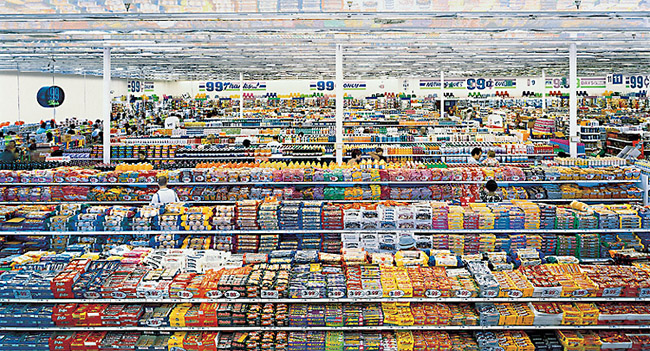So far my posts have mainly focused on reducing your ecological footprint by minimizing persistent waste, particularly plastic. This is an example of what I will call the chemistry or chemical problem in sustainability. Screening plastic from your consumer basket constitutes part of "closing the loop," that is, only participating in the proliferation of materials that can currently be broken down and reused indefinitely. Another component of our efforts will have to address what I'm referring to as the math or numbers problem.
Even if all nondegradable and nonrecyclable materials ceased to be produced and dispersed in our economy and ecology, this would be no guarantee of sustainability. It would allow for the wholesale redistribution of resources for different purposes, but it would not mean they would be enough for ours. Our longevity as a society could easily remain jeopardized by the sheer quantity of our demand for these remaining renewable resources and an inability to satisfy it.
I can take the most basic of these resources as an example: fresh water. It is likely the most essential ingredient to survival that we risk losing access to. Although fresh water is continually produced by natural cycles and treatment, the scale of this process might be outstripped by perceived needs. In order to secure fresh water and similar resources that society will require to go on existing as we know it, we will have to manage our use, perhaps by checking demand, to ensure our needs won't exceed rates of production.
The same holds true for all other renewable resources. Though they can be renewed, lest we destabilize our society, we must not entirely consume them before such turnover can be had. Unfortunately, there is reason to believe that prices as they are determined under our current economic arrangements do not provide the proper incentive to behave this responsibly. Indeed, water, air and favorable weather are consumed publicly and as such easily fall victim to the tragedy of the commons, a phenomenon that has most notably played out in global climate change and our shortcomings in addressing it.
I am not suggesting that all resources should come into private ownership, even if such a thing were possible. I certainly don't think that anybody should have to pay for the right to breathe and I luckily have yet to meet someone whose morality is informed by economics in this way. At the same time, we do need to establish better feedback mechanisms that will inhibit those behaviors that stand to lead to our self-destruction. Attempts to establish markets through cap-and-trade programs were a good place to start and would be the economical thing to do.
Grey Areas
I have proposed defining environmental issues in these two ways, but they are by no means mutually exclusive and there is a region of blurriness between them. In fact, many of our current environmental challenges suffer from both of these conditions. Above I discussed how overconsumption can deplete resources, and that’s how what was originally a problem of numbers can lead to one of chemistry. Take deforestation for example. It has already compounded the chemical problem of greenhouse gases by reducing the planet's ability to absorb them. In addition, though I doubt this day will ever come, if left unchecked this process could lead to the extinction of trees along with all the services they offer. This would mean little for the composition of the atmosphere if other plants could pick up the slack, but what if they too were gone? Or what if trees - or even just particular species - provided services nothing else could?
To make my point clearer, imagine there exists an organism A that is the exclusive producer of product A. If product A is essential to the healthy functioning of our economy, the loss of organism A would translate into serious damages, not to mention the effects on other systems involved. Product A could be anything - a nutrient, a drug, carbon sequestration.
Similarly, if an organism B is the sole decomposer of waste B, with its destruction we lose the digestive pathway for that waste and continued production of it will inevitably clog our biosphere in much the same way that cholesterol clogs arteries. Now, humans are innovative and nature is adaptable. We might be able to invent an industrial process in time to make up for the extinction of this vital form of life. If we fail, however, nature might eventually fill the gap, but we won't last long enough to witness it.
Overconsumption taken to this extreme is a threat to all things that rely on self-replication. Fresh water can be extracted from salt water or produced as a result of the water cycle; its creation does not necessitate preexisting fresh water. On the other hand, a bacterium, despite all our advances in biotechnology, still only comes from other bacteria, unless you think you can recreate the random processes responsible for its evolution. Thus, self-replicating resources always require a starter amount, the decimation of which converts what was once an issue of scale into a potential chemical complication.
The other area where these two types of problems overlap is in addressing one with a solution that causes the other. The case of the math problem causing the chemistry problem is immediately more obvious to me than its opposite. This stems from the fact that so much of our progress has been based on getting more from less. As a consequence, although we haven't always been aware of it, we have been willing to expedite production and related duties using harmful methods. Instead of actually getting more for less, this strategy often results in getting something now and paying later - or more commonly having someone else pay later.
The shortcomings of this approach are manifest in the current condition of the world's oceans. Among other things, they suffer from toxification, a result of our aim to more efficiently deliver food stuffs. In order to get products into the hands of people cheaply and quickly we have resorted to the use of plastic packaging. However, because plastic is so cheap it is easy for people to nonchalantly throw away. This would not necessarily be a problem except that, due to its chemical nature, plastic now comprises the ocean's toxic garbage patches.
It is in this way that we again exchange a numbers problem for a chemical one. The latter in turn can exacerbate the situation and make it worse than it originally was, leaving us with both problems. To that effect, the application of plastic in overcoming barriers to better distributing food has compromised the productivity of ocean fisheries. For reasons such as these I find it hard to justify inducing chemical issues to address numerical problems.
Unified Solutions
Nevertheless, getting more from less is the only way to solve the numbers problem. With world population approaching 7 billion we must achieve gains in productivity to meet its basic needs, not to mention capitalize on the prospect of higher living standards. What doesn’t make sense is exchanging the quality of our public health for these gains, since that defeats the purpose of obtaining them. In spite of this, that phenomenon persists because it leads to islands of greater material wealth and better health amid regions that are forced to bear the costs. As a consequence the latter unnecessarily suffer deterioration in those same areas.
One need only look at attempted solutions to numbers problems to see how easily they can pan out in these ways. The histories of DDT, CFCs and PCBs all too clearly illustrate how inadequately we account for the effects new compounds will have on environment and society. When not stemming from individual self-interest, toxic pollution and its accompanying health effects have resulted from a lack of foresight. I doubt that the initial producers of plastic, for instance, could have known that the versatile substance they were making a living from would today be leaching toxins into our lives. For this reason, it is worth taking a more conservative approach to our choice of materials in problem solving. Many of them will have to come in time-tested forms to ensure that they are biologically innocuous.
In achieving sustainability we face the dual challenge of increasing productivity and preventing the worst effects of toxic pollution. During the industrial revolution, gains in efficiency could not be achieved without environmental degradation. That dynamic by its very nature could never be more than a temporary one and we now have the resources at our disposal to transform it. To start with, as many companies and individuals are already doing, more can be done to replace conventional plastics with bioplastics or otherwise supplant toxic chemicals with biotics, but we can also downsize the scale of our material consumption. Only by thus addressing both the math and chemical problem can we sustainably resolve productivity issues. Until this dual consideration is incorporated into practice on a grand scale, significant increases in quality of life will not be achieved. Instead we will witness to a greater degree than we do today localized increases in affluence attained by pushing costs onto others. Fortunately, the realm of human activity is not a zero-sum game. It’s thanks to this that the average quality of human lives has improved over time and we can go on believing in progress.














